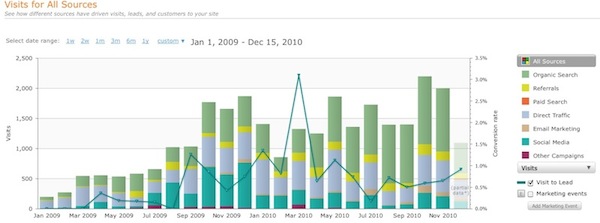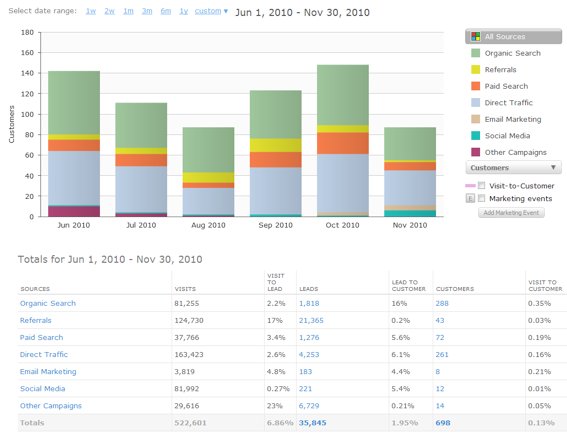Why Should You Analyze Your Campaigns?
As an inbound marketer, you spend hours upon hours creating campaigns to generate traffic, leads, and customers for your business. Whether you're writing blog posts, promoting ebooks, or nurturing warm leads into sales-ready leads, it all takes time. Nothing a marketer does comes quick or easy, which is why it is crucial that we're able to analyze and show the results of our efforts.

By analyzing your campaigns and calculating ROI, you and your team will learn how to make increasingly better and more effective marketing. This will not only improve the bottom line of your business, but will also make you and your marketing team look like rock stars.
What is the Goal of Your Campaign?
First you need to have an overarching goal for the kind of campaign you want to create. Create SMART goals to guide the work you put into every campaign. SMART is an acronym that helps marketers remember to create goals that are Specific, Measureable, Attainable, Relevant, and Timely. If your goals are missing any one of these, it's time to revisit that goal and add it back in. It will be totally pay off in the long run.
Campaigns typically fall into these three goal categories:
- Traffic Campaign - A traffic campaign can use many different outlets to accomplish the end goal of increasing overall site traffic. Most commonly, traffic campaigns involve creating blog posts to increase organic traffic and promoting them via social media outlets, or using pay-per-click advertising to increase traffic overall. Whatever solution you are using, be sure you answer the question "Why do I want to increase my site's traffic?"
- Lead Campaign - If you are looking to increase your leads, then generating offers through content (ebooks, whitepapers, webinars, etc) is most likely where you will spend the majority of your time and marketing efforts. Before you pursue this goal, make sure you have enough traffic to try to convert first. If you don't, that might actually be the challenge you need to overcome first.
- Customer Campaign - So you have traffic that is converting into leads and now nurturing those leads into sales-ready leads has become your main focus. You're generating new content, promoting with blog posts, social media and email. You spend many hours structuring your nurturing campaigns to draw those leads down the sales funnel. But what next? How do you know that your campaigns are working?
Using Sources to Analyze a Campaign
Sources
- Traffic Campaign - The Sources tool shows you the number of visits that you've received to your website from each possible source of traffic on the internet.

PRO TIP: On a PC, hold down the "Control" key ("Command" on a Mac) and then click on the different source types to compare their traffic. This is great for comparing Organic Traffic to Paid Search, for example.
If you are blogging consistently, pay close attention to the organic traffic graph.

Pro Tip: You can view the keywords typed into search engines that found your site in the list below the graph. Check the box to the right of the tool to add the keyword directly to your Keyword tool!
- Leads Campaign - You're getting traffic to your site, your calls-to-action are specific, bright, and clickable and your landing pages are stunning. How can you tell if your campaigns are actually working? In Sources, track your conversion rate by selecting the "Visit to Lead" check box under the source type.

Pro Tip: Make Pay-Per-Click campaigns work for you by attaching your campaigns to landing pages. If you're paying for visits only, you're not getting the best value out of your campaign. Track your Paid Search ads through tracking URLs in the HubSpot tool and compare the keywords to your organic search results. If you're getting more leads from the organic search term than from the paid keyword save your money by eliminating the paid term.
- Customer Campaign - You're getting traffic and leads, but now you'd like to convert those leads into customers. How can Sources help? Once your lead becomes a customer, make sure to close them as a customer in their contact record. This action will populate the appropriate fields in the Sources tool.

Pro Tip: If you're seeing a high visit-to-lead conversion rate, but almost no lead-to-customer conversion or low visit-to-lead conversion rates with a few lead-to-customer conversions, make sure you are providing offers at every stage in the buying cycle.
What Other Analytic Tools Can You Use to Evaluate the Success of a Campaign?
Attend the How to Make Smarter Marketing Decisions Using Data webinar series for a deep dive into what your campaign data are telling you. This two-part webinar series will include in-depth explanations of all of the other tools within HubSpot that can help you analyze your campaigns.
